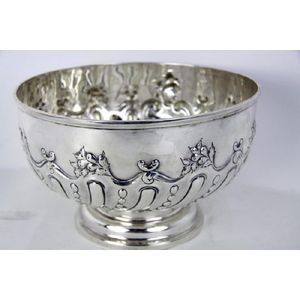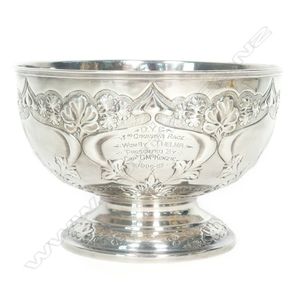Edwardian Silver Rose Bowl with Art Nouveau Design and Inscription
You must be a subscriber, and be logged in to view price and dealer details.
Subscribe Now to view actual auction price for this item
When you subscribe, you have the option of setting the currency in which to display prices to $Au, $US, $NZ or Stg.
- Art Nouveau Period - The Art Nouveau period was a cultural movement that emerged in the late 19th century, and was characterized by its emphasis on natural forms, flowing lines, and a decorative, ornamental style. Art Nouveau was a reaction against the ornate and heavily stylized designs of the previous era, and sought to create a new, more organic aesthetic.
Art Nouveau was characterized by its use of sinuous, curving lines, as well as a focus on natural elements such as flowers, vines, and other organic shapes. Art Nouveau designers sought to create a total work of art, in which every element of a building or object was designed to be harmonious with the overall design.
Some of the most iconic examples of Art Nouveau design include the Paris Metro entrances designed by Hector Guimard, the works of the artist Alphonse Mucha, and the architecture of Victor Horta in Brussels.
The Art Nouveau period was at its peak between 1890 and 1910, but began to decline in popularity by the start of World War I. However, Art Nouveau remains an important influence on design and art to this day, and continues to be celebrated for its emphasis on natural forms and decorative style. - Edwardian - The Edwardian period of English furniture and decorative arts design is named for Edward VII (1841 ? 1910) who was King of the United Kingdom and the British Dominions and Emperor of India for the brief period from 1901 until his death in 1910. It follows the Victorian period, in turn was followed by the Art Nouveau and Art Deco styles. In Australia, designs of this period are also known as being in the Federation style.
- Embossed / Repousse - Embossing, also known as repousse, is the technique of decorating metal with raised designs, by pressing or beating out the design from the reverse side of the object.It is the opposite of chasing, where the decoration is applied from the front. An embossed or repoussed object may have chasing applied to finish off the design.
This item has been included into following indexes:
- bowls and dishes, silver
- Deakin, James & Son - silver, maker or retailer 70
- rose bowl - silver items 89
Visually similar items

Chinese Swatow blue and white bowl Ming Dynasty (1368-1644) decorated with floral motifs. Height 13.5 cm diameter 31.5 cm. Provenance: from the T. Stewart's collection, NSW

An Iznik green decorated white glazed bowl, Persian, 15/17th century. 20 cm diameter

A Chinese blue and white lotus bowl decorated, with on the interior with double vajra, mid 16th century, 10 cm high, 22.7 cm diameter. Provenance: Rustam, Ujung Pandang, late 1960's

A Victorian sterling silver punch bowl. Maker C.S. Ltd., London 1897. Repousse chased sides in 'Renaissance' manner, with two large engraving cartouche on the sides, raised on a broad circular foot base. 1620gm.
